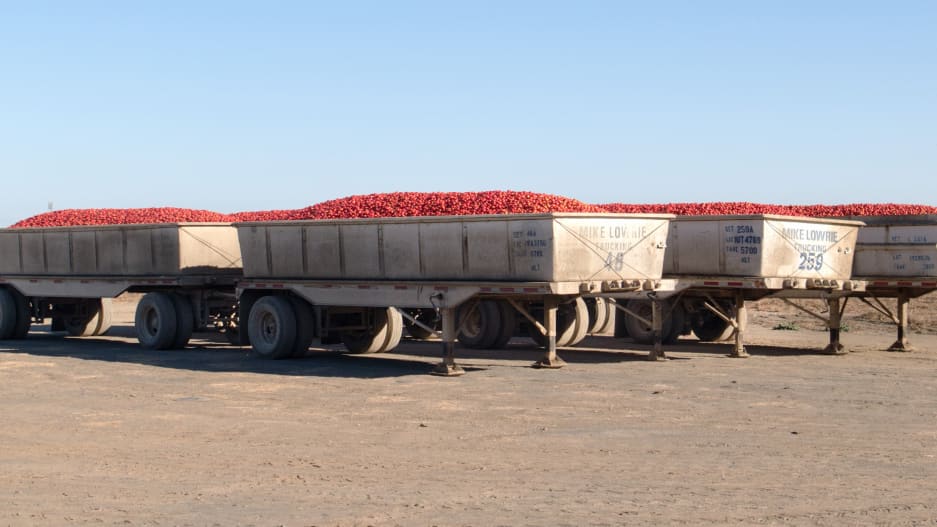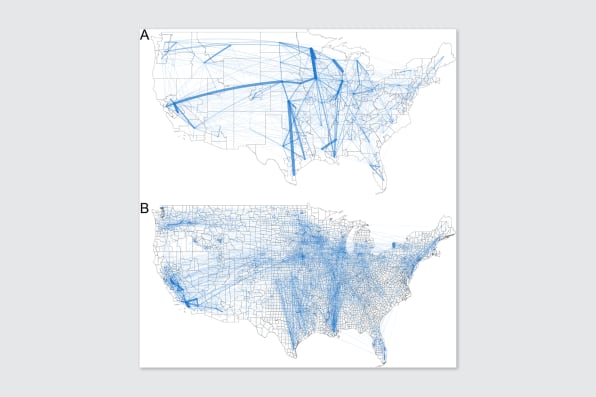
Posted on 11/02/2019 8:08:49 AM PDT by null and void
By 3 minute Read

Most of our food is moved across great distances—and through many different forms of transit—before it reaches our plates.
My team at the University of Illinois just developed the first high-resolution map of the U.S. food supply chain.
Our map is a comprehensive snapshot of all food flows between counties in the U.S.—grains, fruits and vegetables, animal feed, and processed food items.
To build the map, we brought together information from eight databases, including the Freight Analysis Framework from Oak Ridge National Laboratory, which tracks where items are shipped around the country, and Port Trade data from the U.S. Census Bureau, which shows the international ports through which goods are traded.
We also released this information in a publicly available database. 
This map shows how food flows between counties in the U.S. Each line represents the transportation of all food commodities, along transit routes, such as roads or railways. [Image: Environmental Research Letters (2019)]
What does this map reveal?
1. Where your food comes from
Now, residents in each county can see how they are connected to all other counties in the country via food transfers. Overall, there are 9.5 million links between counties on our map.
All Americans, from urban to rural are connected through the food system. Consumers all rely on distant producers, agricultural processing plants, food storage like grain silos and grocery stores, and food transportation systems.
For example, the map shows how a shipment of corn starts at a farm in Illinois, travels to a grain elevator in Iowa before heading to a feedlot in Kansas, and then travels in animal products being sent to grocery stores in Chicago.
2. Where the food hubs are
At over 17 million tons of food, Los Angeles County received more food than any other county in 2012, our study year. It shipped out even more: 22 million tons.
California’s Fresno County and Stanislaus County are the next largest, respectively. In fact, many of the counties that shipped and received the most food were located in California. This is due to the several large urban centers, such as Los Angeles and San Francisco, as well as the productive Central Valley in California.
We also looked for the core counties—the places that are most central to the overall structure of the food supply network. A disruption to any of these counties may have ripple effects for the food supply chain of the entire country.
We did this by looking for counties with the largest number of connections to others, as well as those that score highly in a factor called “betweenness centrality,” a measurement of the places with the largest fraction of the shortest paths.
San Bernardino County led the list, followed again by a number of other California transit hubs. Also on the list are Maricopa County, Arizona; Shelby County, Tennessee; and Harris County, Texas.
However, our estimates are for 2012, an extreme drought year in the Cornbelt. So, in another year, the network may look different. It’s possible that counties within the Cornbelt would show up as more critical in non-drought years. This is something that we hope to dig into in future work.
3. How food travels from place to place
We also looked at how much food is transported between one county and another.
Many of the largest food transport links were within California. This indicates that there is a lot of internal food movement within the state.
One of the largest links is from Niagara County to Erie County in New York. That’s due to the flow of food through an important international overland port with Canada.
Some of the other largest links were inside the counties themselves. This is because of moving food items around for manufacturing within a county—for example, milk gets off a truck at a large depot and is then shipped to a yogurt facility, then the yogurt is moved to a grocery distribution warehouse, all within the same county.
The food supply chain relies on a complex web of interconnected infrastructure. For example, a lot of grain produced throughout the Midwest is transported to the Port of New Orleans for export. This primarily occurs via the waterways of the Ohio and Mississippi Rivers.
The infrastructure along these waterways—such as locks 52 and 53—are critical, but have not been overhauled since their construction in 1929. They represent a serious bottleneck, slowing down innumerable supply chains nationwide, including that of grain. If they were to fail entirely, then commodity transport and supply chains would be completely disrupted.
Railroads are also important for moving grain. Fresh produce, on the other hand, is often moved around the country by refrigerated truck. This is due to the need to keep fresh fruits and vegetables—relatively high value agricultural products—cool until they reach the consumer. In future work, we hope to evaluate the specific infrastructure that is critical to the U.S. food supply chain.
Megan Konar is assistant professor of civil and environmental engineering at University of Illinois at Urbana-Champaign. This post originally appeared on The Conversation.
Worth going to the link, there are a couple good graphics that wouldn't import gracefully..
It looks like Brainerd, MN is a major hub.
Why?
Well, at mickyD’s place yesterday, I was reminded(via mat in plastic tray) that half of the veggies in the US come from kali and 2/3 of the fruits and nutz(?) come from kali. Just think how awesome it would be if the state wasn’t oppressed by libs.
Bump
A pictorial homage to the invisible hand.
A boycott of California produce?
You obviously know nothing about agriculture in California and believe all the stereotypes about the state so rampant around here.
WHAT does the ‘food (corn) to fuel’ supply chain look like?
Thanks to the prof for telling the Deep State / terrorists what to attack.
This is pretty cool! It brings reality into perspective. Foods don’t just grow prepackaged in the back storeroom of the grocery store like our newest generation thinks. :)
Food for thought.
I travel through much of the farm land of Cali on a yearly basis and have known it’s a key source for many of America’s produce and meats but I didn’t realize it was quite so extensive.
I guess when Cali secedes we will have to make sure those key growing areas stay in America. They can have L.A. and the Bay Area; the rest we keep.
Perhaps a convenient Central transportation distance areas of production
This article only hints at a small sliver of the corn path:
For example, the map shows how a shipment of corn starts at a farm in Illinois, travels to a grain elevator in Iowa before heading to a feedlot in Kansas, and then travels in animal products being sent to grocery stores in Chicago.
One problem I see with the map is it doesn’t show any traffic from Southern California along I-10/I-20 corridor to the east coast. I drive it every now and then from DFW to Phoenix and back and can tell you it’s solid 18 wheelers both ways. And, if your not willing to run 80~85 mph better drive on the service road....
“You obviously know nothing about agriculture in California and believe all the stereotypes about the state so rampant around here.”
Your comment is completely unfair. null and void is asking the same question I am and I have zero stereotypes about California and know quite a bit about agriculture in California. I too was surprised to see that LA County - which has seriously fallen from its agricultural heyday ( https://la.curbed.com/2016/4/7/11385560/los-angeles-agricultural-history-urban-farming ) is exporting as much in food products as it is. I wondered if it was from aggregate massing of outside LA products - in other words, LA is a transportation hub and the food products are grown outside of the county.
After all LA County only has 2.2 percent of its land devoted to just over 1,000 farms. Fifty years ago it was over 20 percent. http://www.laalmanac.com/agriculture/ag02.php
null and void is right to be perplexed.
The Omnivores Dilemma is a great read. Also a bit is a reality check for the liberal that wrote it.
I loved the last chapter on natural farming, it showed the invisible Hand quite well.
Brainerd, MN — Winter wheat
For centuries people got their food from their own backyard/land, growing their own veggies, curing their meat, fresh milk and eggs.
Kind of sad things changed. Those skills are now lost to most people. Food is big business, travels across the country so not as fresh, and prices keep getting higher.
I suspect a lot of that truck traffic is moving imports from the Ports of LA and Long Beach. That’s a lot of freight, but I’ll bet hardly any of it involves food products.
A bit O/T, but California still produces 90% of the nation’s wine. By comparison, Texas has had enormous growth over the past decade, and just passed 400 in wineries in the state. California has nearly 8000 wineries.
Disclaimer: Opinions posted on Free Republic are those of the individual posters and do not necessarily represent the opinion of Free Republic or its management. All materials posted herein are protected by copyright law and the exemption for fair use of copyrighted works.